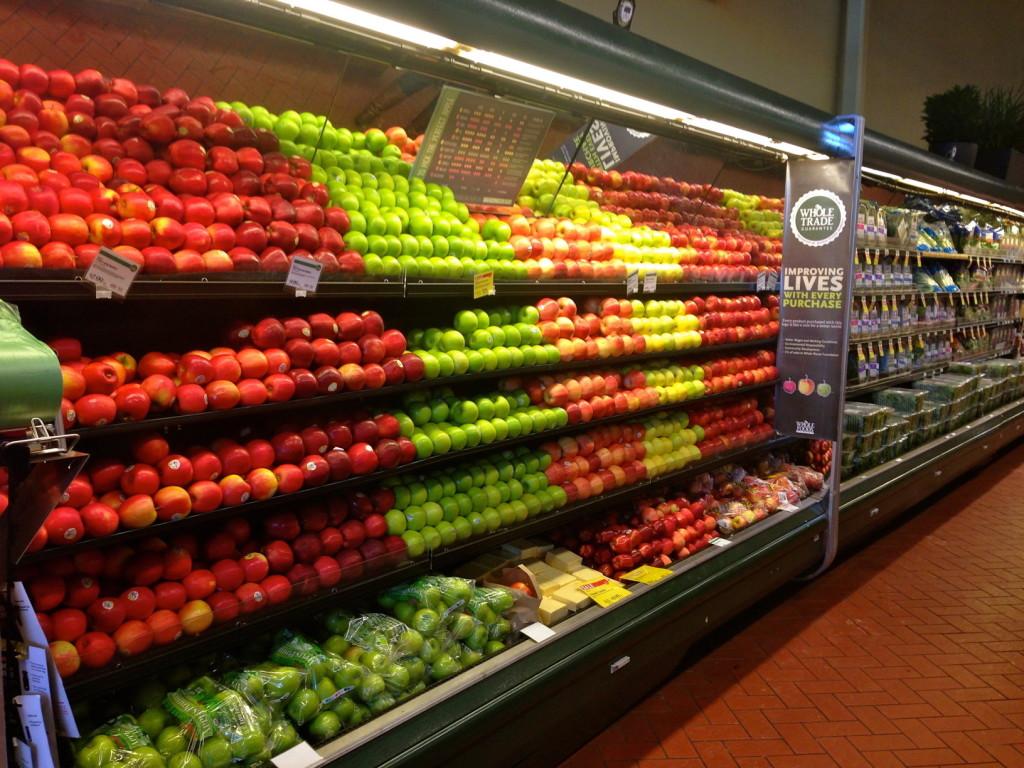The Lowdown on Nutrition: Tricks, Trends, and Tools
In a sea of choices, choose wisely
Take your pick: A fresh juicy pomegranate or a sugary bag of Chips Ahoy®? In fact, take your pick on just about anything you put into your body.
With grocery store deception, new food trends arising each year, and various “guides” on what you should be eating, it can be unclear on what exactly to be putting into your body.
Buying Right: How to Steer Clear from Grocery Store Tricks
Walking through a grocery store you are immediately encountered with many possibilities of what to purchase: fruits, vegetables, dairy products, and of course, the caloric, artificial, and sugary snacks.
There are many tricks grocery stores use to get their products sold, and unfortunately many people fall for these every time they walk in their local supermarket.
Almost all grocery stores use the “eye-level” method. This means that stores will put the most appealing items at eye level. You can usually find the most sugary, salty, and caloric foods there.
This proved true in the aisles of both a Whole Foods store and a Safeway store.

But, how can we steer clear of these grocery store tricks? The first step is to find out just how grocery stores are organized.
A Whole Food Market Healthy Eating specialist, Julie Magnussen, explains that many grocery stores are organized with produce, meats, and fresh items on the perimeters of the stores.
“The most natural and beneficial foods for you are usually on the outside of the store, so if you shop in these sections you’ll be good to go,” Magnussen said.
Even though the items on the perimeters of stores tend to be pricier, the extra buck is worth the nutritional benefits.
“Buying food from the outside areas of the store is the best way to ensure that the food you are eating is rich in fiber, vitamins, and nutrients,” Magnussen said. “These foods are known as ‘super foods.’ Usually, these are your fruits, vegetables, and grains.”
Another way to make sure what you are buying is beneficial to your health is to consider buying organic.
Magnussen explains that people tend to buy organic because of both its health benefits and environmental benefits.
“It has no pesticides or artificial contaminants. Organic food is also good for the environment, because it uses no chemicals in any process.”
The only problem with buying organic is that it tends to be on the pricey side.
“The government subsidizes conventional growth and organic food requires more labor. It also is higher quality and costs more money to become a certified organic,” Magnussen said of the higher prices.
And lastly, make sure to look at shelves not only at eye level, but to look at the top and bottom shelves. This can be the difference between choosing a package of oreos or a bag of healthy crackers to snack on.

The first step to eating right, is shopping right.
Food Trends of 2013: Should you participate?
With the thousands of food choices in grocery stores and supermarkets today, certain foods soar above the rest in sales each year. These are what we call food trends.
2013 has brought in many food trends, but some of the most popular fads have been going gluten-free and anything involving the leafy green veggie, kale.
But, what makes a certain food item suddenly “trendy”?
Many times celebrities, or other well-known figures, will show off a type of food, causing it’s popularity to skyrocket. Not everything that Jennifer Anniston eats, however, will go viral. But, some items just catch on and are brought into households across America.
Many people this year have turned their diets gluten-free, not because they were required to for health reasons, but because companies, stores, and restaurants have been marketing the gluten-free lifestyle as a successful way to lose weight.
Food trends however, are not always 100 percent beneficial, and the gluten-free fad is an example of this.
First off, the reason that people are gluten-free to is because of a medical condition known as celiac disease. According to an article published in November on Psychology Today, eating gluten-free food when it is not medically necessary can have negative effects because it denies our bodies carbohydrates that are necessary for digestion, stamina and fuel.

Senior Anna Pstasinski, who found out that she had celiac disease two years ago, shares similar concerns about the gluten-free trend.
“I understand why people choose to eat gluten free when they don’t have to because many times it can be healthier. But, gluten free substitutes in things like bread have way more calories than normal bread and many people don’t know that,” Pstasinksi said.
Gluten, a substance found in grains (especially wheat), is actually a hard thing to avoid when choosing different food options. Pstasinksi explains that when someone has celiac disease they are restricted to a lot of fresh foods and proteins.
Just remember to think twice about joining the gluten-free trend because different trends can work differently in different bodies.
But, another trend that may not have these outlying health hazards is the kale trend. The sales of kale, which is a variety of cabbage with many nutritional advantages, have skyrocketed this year. Kale is very high in both calcium and different vitamins, as well as having few calories.
However while kale might be high in nutritional value, sometimes the taste is not as great.
Senior Elli Marrs, who is described by her friends as a foodie, said that “kale alone can taste bitter”.
Marrs is not the only one to feel this way. Products with kale as a main ingredient have also been flying off the shelves this year. According to a Food Business News article, popular kale products in 2012 and 2013 have been kale chips, kale yogurt dip, and kale popsicles. Jamba Juice has even added kale as an ingredient to some smoothies.


To help kale’staste be up to standard with it’s nutrition, Marrs suggests incorporating kale into other healthy items. Her favorites are a kale and peanut chicken salad, along with kale sweet potato wraps.
With a high nutritional value and a delectable taste, it is no wonder that kale has become a food trend. And on top of that, kale is always in season. Check your local grocery store for kale products in the summer, fall, winter or spring.
So, what should we be eating?
With the everchanging guidelines on what we should be eating and how much of it we should eat, it can be hard to interpret exactly what foods we should be fueling our bodies with.
Five years ago after the ending of the traditional food pyramid, the FDA introduced a new key to what we should be eating with the updated MyPyramid.
MyPyramid, however, was short lived, and again it still wasn’t clear enough on what we should be eating. In 2011, the FDA came up with a simpler idea of MyPlate.
MyPlate maps out an average plate with the portion sizes of how much dairy, vegetables, fruits, grains, and protein you should eat in a typical meal. This new approach to inform consumers on what to eat was much needed considering that only 16% of Americans followed the Food Guide Pyramid from 1992 according to an article on Ace Fit.
MyPlate allows for a simpler interpretation of what we should be eating, but is this guide accurate?
“My Plate is an ok guideline. However, the fruit category tends to be a little high. There is some research that our body uses/processes fruit sugar just like any other sugar. Therefore, we should be replacing fruit with more vegetables. The thing that concerns me with my plate is the portions. It is saying we should fill our plate, which may not be the best way to go,” said certified Max Muscle nutritionist Megan Casey.

So what should we be using as a guideline to live a healthy life?
“ The best thing to do is think about what the food is doing to your body, is it helping you or hurting you?” Casey said. “Eating clean/fresh foods is always the best option.”
“If you’re looking for a way to start eating healthier, start by decreasing your sugar intake, eat a lean protein at every meal, grill/bake meat instead of frying it, and use healthy fats (avocado, coconut oil) instead of unhealthy fats (mayonnaise),” said Casey.
“Also try cutting one thing out at a time, if you drink a soda every day, try doing it every other day, then every third day. Slowly changing your behaviors will lead to more effective long term change, rather than doing an overhaul of your whole life.”
Overall, food guidelines are not one size fits all. Evaluate your eating habits, and then see if you need to make a change, and if you do, make that change.
Everyone has a different body that will have different reactions to different foods. Just remember that if you want to have a more nutritious diet, it’s up to you.








